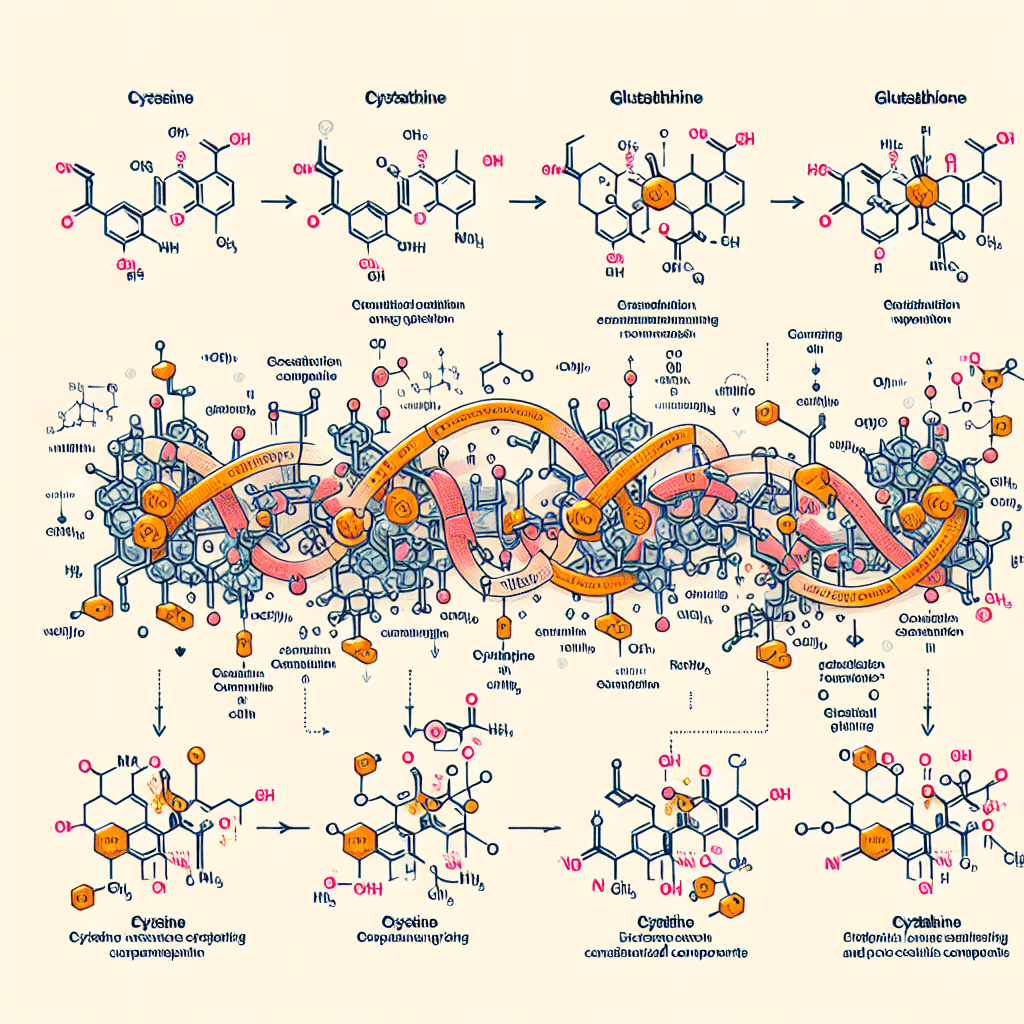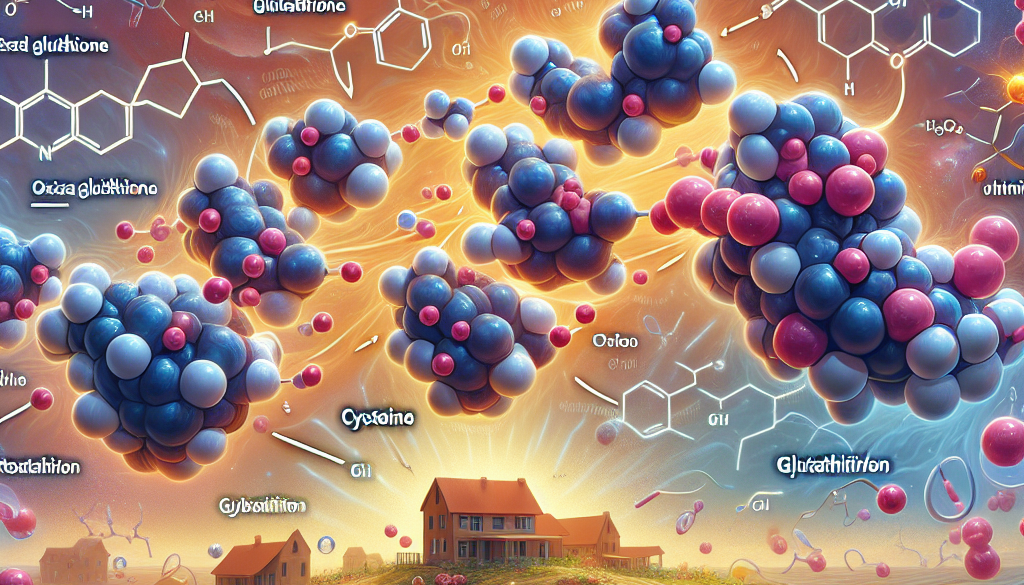Cysteine Glutathione Reaction: Overview
-
Table of Contents
- Cysteine-Glutathione Reaction: Essential Pathway in Antioxidant Defense
- Understanding the Basics of Cysteine and Glutathione
- The Cysteine-Glutathione Reaction Mechanism
- Role of Cysteine-Glutathione in Antioxidant Defense
- Implications for Health and Disease
- Therapeutic Applications and Supplementation
- Research and Case Studies
- Conclusion: Key Takeaways of the Cysteine-Glutathione Reaction
- Enhance Your Health with ETprotein’s High-Quality Protein Products
Cysteine-Glutathione Reaction: Essential Pathway in Antioxidant Defense

The cysteine-glutathione reaction is a crucial biochemical pathway that plays a vital role in maintaining the redox balance within cells and protecting them from oxidative stress. This article provides an in-depth overview of the cysteine-glutathione reaction, its significance in cellular processes, and its implications for health and disease.
Understanding the Basics of Cysteine and Glutathione
Cysteine and glutathione are sulfur-containing compounds that are integral to the antioxidant defense system of the body. Cysteine is an amino acid that serves as a building block for proteins, while glutathione is a tripeptide composed of three amino acids: cysteine, glutamic acid, and glycine.
- Cysteine: It is not only a precursor to glutathione but also plays a role in protein synthesis and various metabolic processes.
- Glutathione (GSH): Often referred to as the “master antioxidant,” glutathione is involved in detoxification, immune function, and the maintenance of the cellular redox state.
The Cysteine-Glutathione Reaction Mechanism
The synthesis of glutathione from cysteine and other precursors is a two-step enzymatic process involving gamma-glutamylcysteine synthetase and glutathione synthetase. The reaction proceeds as follows:
- Cysteine combines with glutamic acid in the presence of ATP and the enzyme gamma-glutamylcysteine synthetase to form gamma-glutamylcysteine.
- The gamma-glutamylcysteine then reacts with glycine, catalyzed by glutathione synthetase, to produce glutathione.
This reaction is critical for maintaining adequate levels of glutathione within cells, which is essential for combating oxidative stress and maintaining cellular health.
Role of Cysteine-Glutathione in Antioxidant Defense
Glutathione plays a central role in the body’s antioxidant defense system by directly scavenging free radicals and by serving as a substrate for glutathione peroxidase, an enzyme that reduces peroxides:
- Direct scavenging: Glutathione reacts with reactive oxygen species (ROS) such as hydrogen peroxide, transforming into its oxidized form, glutathione disulfide (GSSG).
- Enzymatic reduction: Glutathione peroxidase uses GSH to reduce lipid peroxides and hydrogen peroxide, generating water or corresponding alcohols and GSSG.
The ratio of reduced glutathione (GSH) to oxidized glutathione (GSSG) within cells is a critical indicator of cellular oxidative stress.
Implications for Health and Disease
The cysteine-glutathione reaction has significant implications for health and disease. Adequate levels of cysteine and glutathione are associated with:
- Protection against oxidative stress-related conditions such as cardiovascular diseases, neurodegenerative disorders, and cancer.
- Enhanced immune function and resistance to infections.
- Improved detoxification of xenobiotics and heavy metals.
Conversely, deficiencies in cysteine or glutathione can lead to increased susceptibility to oxidative damage and a range of health issues.
Therapeutic Applications and Supplementation
Given the importance of the cysteine-glutathione pathway, therapeutic strategies have been developed to enhance glutathione levels in the body:
- Oral supplementation with cysteine donors such as N-acetylcysteine (NAC) can boost cellular glutathione levels.
- Direct supplementation with glutathione, although less effective due to its breakdown in the digestive system.
- Use of compounds that increase the activity of enzymes involved in glutathione synthesis or recycling.
These approaches have shown promise in the treatment of conditions associated with oxidative stress and glutathione deficiency.
Research and Case Studies
Several studies have highlighted the therapeutic potential of targeting the cysteine-glutathione pathway:
- A study on patients with chronic obstructive pulmonary disease (COPD) showed that NAC supplementation improved lung function and reduced exacerbations.
- Research on neurodegenerative diseases such as Parkinson’s and Alzheimer’s has indicated that glutathione depletion contributes to neuronal damage, suggesting a potential role for glutathione-enhancing therapies.
- In cancer treatment, modulation of glutathione levels can influence the sensitivity of tumor cells to chemotherapy and radiation.
These examples underscore the therapeutic relevance of the cysteine-glutathione reaction in clinical settings.
Conclusion: Key Takeaways of the Cysteine-Glutathione Reaction
The cysteine-glutathione reaction is a cornerstone of the body’s antioxidant defense system, with far-reaching implications for health and disease. Understanding and harnessing this pathway can lead to improved therapeutic strategies for a variety of conditions linked to oxidative stress. The key takeaways include:
- The cysteine-glutathione reaction is essential for synthesizing glutathione, the master antioxidant.
- Glutathione protects cells from oxidative damage and supports immune function.
- Therapeutic strategies aimed at boosting glutathione levels can mitigate oxidative stress-related diseases.
- Supplementation with cysteine donors or compounds that enhance glutathione synthesis may offer health benefits.
As research continues to unravel the complexities of the cysteine-glutathione reaction, the potential for novel treatments and preventative measures grows, offering hope for improved health outcomes.
Enhance Your Health with ETprotein’s High-Quality Protein Products
If you’re looking to support your body’s antioxidant defenses, consider incorporating high-quality protein products from ETprotein into your diet. ETprotein offers a range of organic bulk vegan proteins and L-(+)-Ergothioneine (EGT) that can help maintain optimal health and well-being.
About ETprotein:
ETprotein, a reputable protein and L-(+)-Ergothioneine (EGT) Chinese factory manufacturer and supplier, is renowned for producing, stocking, exporting, and delivering the highest quality organic bulk vegan proteins and L-(+)-Ergothioneine. They include Organic rice protein, clear rice protein, pea protein, clear pea protein, watermelon seed protein, pumpkin seed protein, sunflower seed protein, mung bean protein, peanut protein, and L-(+)-Ergothioneine EGT Pharmaceutical grade, L-(+)-Ergothioneine EGT food grade, L-(+)-Ergothioneine EGT cosmetic grade, L-(+)-Ergothioneine EGT reference grade and L-(+)-Ergothioneine EGT standard. Their offerings, characterized by a neutral taste, non-GMO, allergen-free attributes, with L-(+)-Ergothioneine purity over 98%, 99%, cater to a diverse range of industries. They serve nutraceutical, pharmaceutical, cosmeceutical, veterinary, as well as food and beverage finished product distributors, traders, and manufacturers across Europe, USA, Canada, Australia, Thailand, Japan, Korea, Brazil, and Chile, among others.
ETprotein specialization includes exporting and delivering tailor-made protein powder and finished nutritional supplements. Their extensive product range covers sectors like Food and Beverage, Sports Nutrition, Weight Management, Dietary Supplements, Health and Wellness Products, and Infant Formula, ensuring comprehensive solutions to meet all your protein needs.
As a trusted company by leading global food and beverage brands and Fortune 500 companies, ETprotein reinforces China’s reputation in the global arena. For more information or to sample their products, please contact them and email sales(at)ETprotein.com today.














